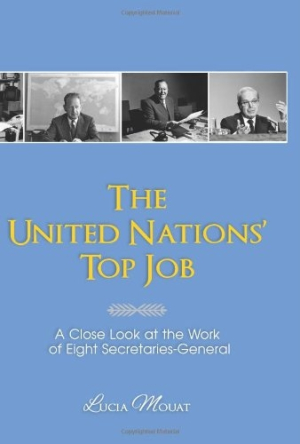The United Nations' Top Job
A Close Look at the Work of Eight Secretaries-General
Mouat’s prowess as a journalist is clear in the extensive interviews and study of historical documents.
The United Nations secretary-general is the epitome of diplomacy—having to not only communicate between governments, but also do it without causing hurt or alienation. Is such a balance even possible in a complex world arena, and without much power to back it up? Lucia Mouat attempts to show how these ideals have played out in real life. The United Nations’ Top Job: A Close Look at the Work of the Eight Secretaries-General examines eight individuals from eight nations and, in the process, provides a sweeping look at world politics and history.
Mouat begins with a brief look at the purpose and history of the United Nations and an examination of the intricacies of the role of secretary-general. The bulk of the book contains chapters that focus on each of the people who’ve held the job. Each chapter discusses how that secretary-general was chosen for the post, the crises each faced, the particular skills each one brought to the UN, and the legacy each left behind.
Eight men from eight different nations have presided over trying times, from 1946 to the present. Mouat lauds the individual strengths and leadership styles of each of the secretaries-general and discusses how they approached challenges during their tenures. As a result, the book gives an overview of recent world history and politics: U Thant’s role in averting disaster during the Cuban missile crisis, Javier Pérez de Cuéllar’s persistent efforts to bring resolution to the Cold War, Kofi Annan’s response to mass killing in Rwanda, and Ban Ki-moon’s devotion to protecting the environment.
Mouat’s fascination with the United Nations and the position of secretary-general shines through in her thorough, detailed research, and her prowess as a journalist is clear in the extensive interviews and study of historical documents. She clearly has admiration for each of the people who’ve filled the office, but even in the midst of her appreciation, she’s honest about the limits of their accomplishments and the office itself.
The book is more encyclopedia than narrative, focusing on historical information rather than drawing out the tensions and personalities that shaped history. Quotes from interviews often inject personality and voice that complement the straightforward tone of the rest of the text: “’[Dag Hammarskjöld] was a shy, quite awkward intellectual who was spectacularly bad at dealing with people,’ recalled Sir Brian. ‘But the most amazing thing about him was that you could go to Rio, New Delhi, or Cape Town, and the taxi driver would have heard of him and have an astonishingly clear idea of what he was trying to do.’”
The patience, persistence, mediative skill, and clear thinking of the secretaries-general provide a refreshing contrast to the coercion and manipulation that seem to dominate American two-party politics. The multinational approach of the United Nations and the varied backgrounds of the secretaries-general are particularly enlightening in the face of the ethnocentrism that often creeps into the news media’s view of history and politics. The United Nations’ Top Job is a great read for those fascinated by the people behind world history and politics.
Reviewed by
Melissa Wuske
Disclosure: This article is not an endorsement, but a review. The publisher of this book provided free copies of the book and paid a small fee to have their book reviewed by a professional reviewer. Foreword Reviews and Clarion Reviews make no guarantee that the publisher will receive a positive review. Foreword Magazine, Inc. is disclosing this in accordance with the Federal Trade Commission’s 16 CFR, Part 255.

